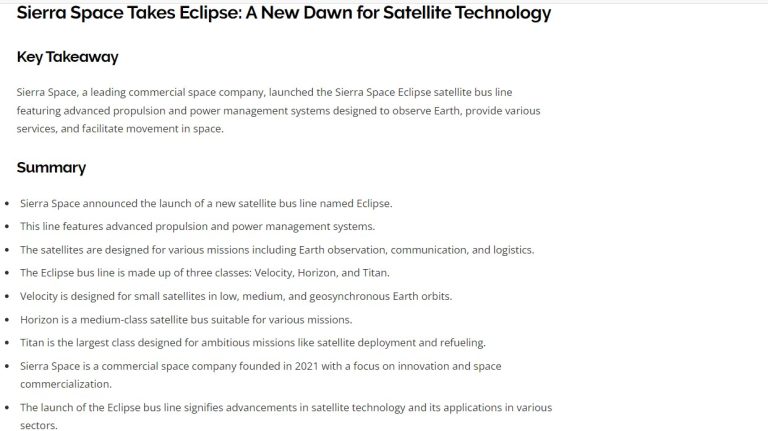Sierra Space Takes Eclipse: A New Dawn for Satellite Technology
Key Takeaway
Sierra Space, a leading commercial space company, launched the Sierra Space Eclipse satellite bus line featuring advanced propulsion and power management systems designed to observe Earth, provide various services, and facilitate movement in space.
Summary
- Sierra Space announced the launch of a new satellite bus line named Eclipse.
- This line features advanced propulsion and power management systems.
- The satellites are designed for various missions including Earth observation, communication, and logistics.
- The Eclipse bus line is made up of three classes: Velocity, Horizon, and Titan.
- Velocity is designed for small satellites in low, medium, and geosynchronous Earth orbits.
- Horizon is a medium-class satellite bus suitable for various missions.
- Titan is the largest class designed for ambitious missions like satellite deployment and refueling.
- Sierra Space is a commercial space company founded in 2021 with a focus on innovation and space commercialization.
- The launch of the Eclipse bus line signifies advancements in satellite technology and its applications in various sectors.
The Complete Story
The space industry is experiencing a boom, driven by innovation and a growing commercial sector. At the forefront of this movement is Sierra Space, a leading commercial space company dedicated to pushing the boundaries of what’s possible. Their latest development, the Eclipse satellite bus line, promises to be a game-changer.
Launched in April 2024, the Eclipse line represents a significant leap forward in satellite technology. These next-generation satellite platforms boast advanced propulsion and power management systems, making them highly versatile and adaptable for a wide range of missions.
But what exactly are satellite buses, and why is the Eclipse line so groundbreaking?
Understanding Satellite Buses
A satellite bus, in essence, is the backbone of a satellite. It provides the core structure, housing essential systems like power, propulsion, thermal control, and communication equipment. Essentially, it’s the platform upon which the specific mission-oriented payloads are built.
Traditionally, satellite buses have been limited in their capabilities. One bus might be suitable for Earth observation, while another would be needed for communication purposes. This lack of flexibility often meant higher costs and longer development times.
The Eclipse Advantage: Scalability and Versatility
The beauty of the Sierra Space Eclipse line lies in its modularity. The line is comprised of three distinct classes: Velocity, Horizon, and Titan. Each class caters to a specific mission profile, offering a perfect blend of size, power, and functionality.
- Velocity: Designed for agility and maneuverability, the Velocity bus is ideal for small satellites operating in Low Earth Orbit (LEO), Medium Earth Orbit (MEO), and Geosynchronous Earth Orbit (GEO). This class is perfect for missions requiring high-precision observation or rapid response capabilities.
- Horizon: Striking a balance between size and capability, the Horizon bus is a versatile workhorse. Well-suited for a broad spectrum of missions, from Earth observation and communication to missile warning and defense applications, the Horizon offers a reliable and powerful platform for diverse needs.
- Titan: A true powerhouse, the Titan bus is the heavyweight champion of the Eclipse line. Designed for the most demanding missions, the Titan is equipped for tasks like satellite deployment, space logistics, and even refueling operations in orbit.
This modular approach allows Sierra Space to offer a “one-stop shop” solution for satellite development. By selecting the appropriate Eclipse bus class and integrating mission-specific payloads, companies and organizations can create highly customized satellites tailored to their exact requirements. This not only reduces development times but also streamlines costs and improves overall mission efficiency.
The Eclipse Effect: A Brighter Future for Space Exploration
The implications of the Sierra Space Eclipse line extend far beyond the technical specifications. This new generation of satellite buses has the potential to revolutionize various aspects of space exploration and commercial space activity.
- Enhanced Earth Observation: The Eclipse line’s advanced capabilities will lead to more powerful and sophisticated Earth observation satellites. This will allow for more detailed monitoring of our planet’s climate, resources, and environmental changes.
- Improved Communication Infrastructure: The Eclipse line can create a new era of communication satellites, providing broader coverage, higher bandwidth, and more reliable connections across the globe.
- Space Logistics and Infrastructure Development: The Titan class, with its refueling capabilities, opens doors for the development of in-orbit infrastructure, enabling missions further into space and fostering a more sustainable space economy.
Sierra Space’s Eclipse line is a testament to the rapid advancements happening in the space industry. With its focus on scalability, versatility, and power, the Eclipse line paves the way for a brighter future in space exploration, observation, and communication. As space becomes more accessible and commercially viable, the possibilities offered by the Eclipse line are truly limitless.

